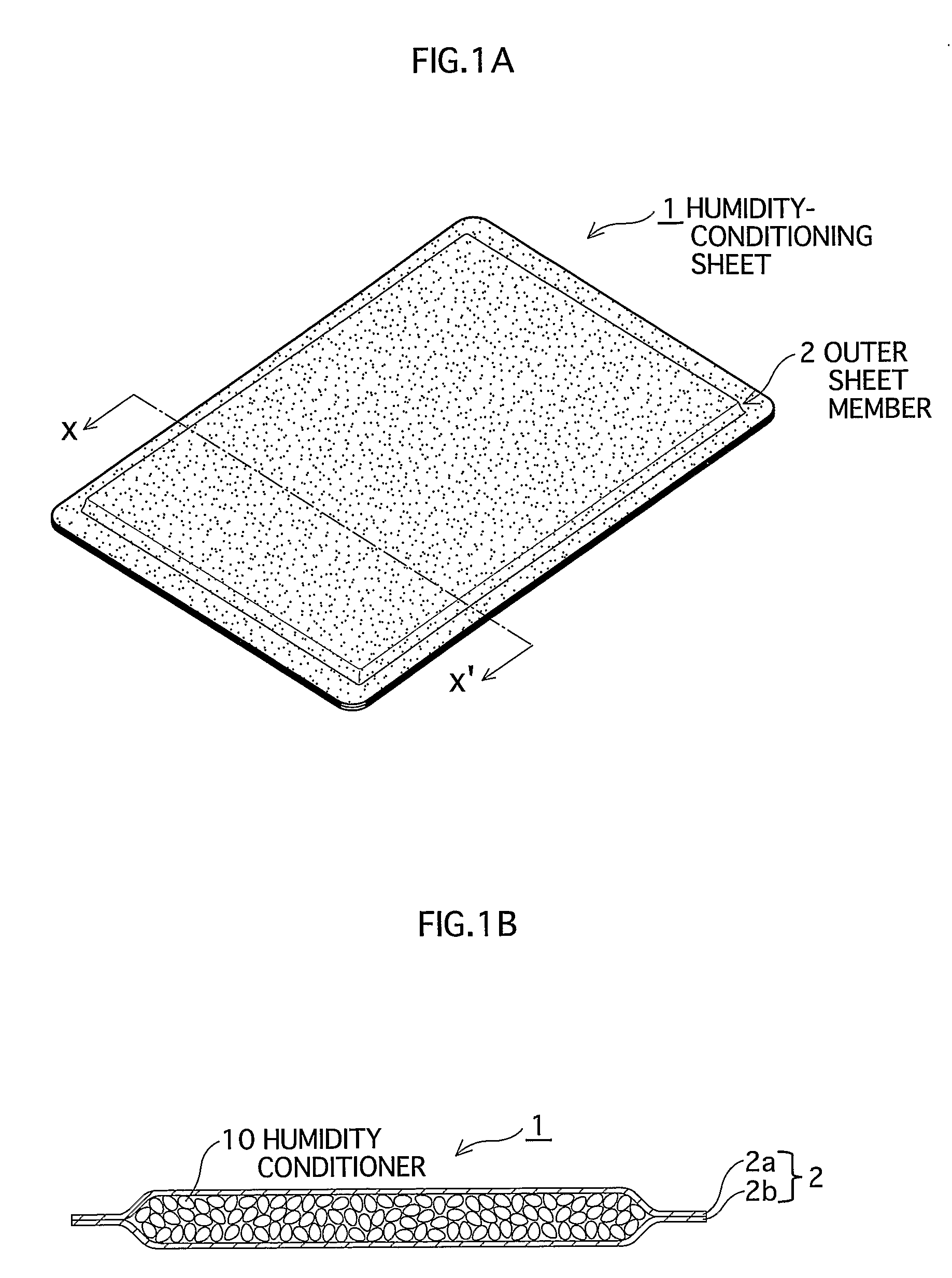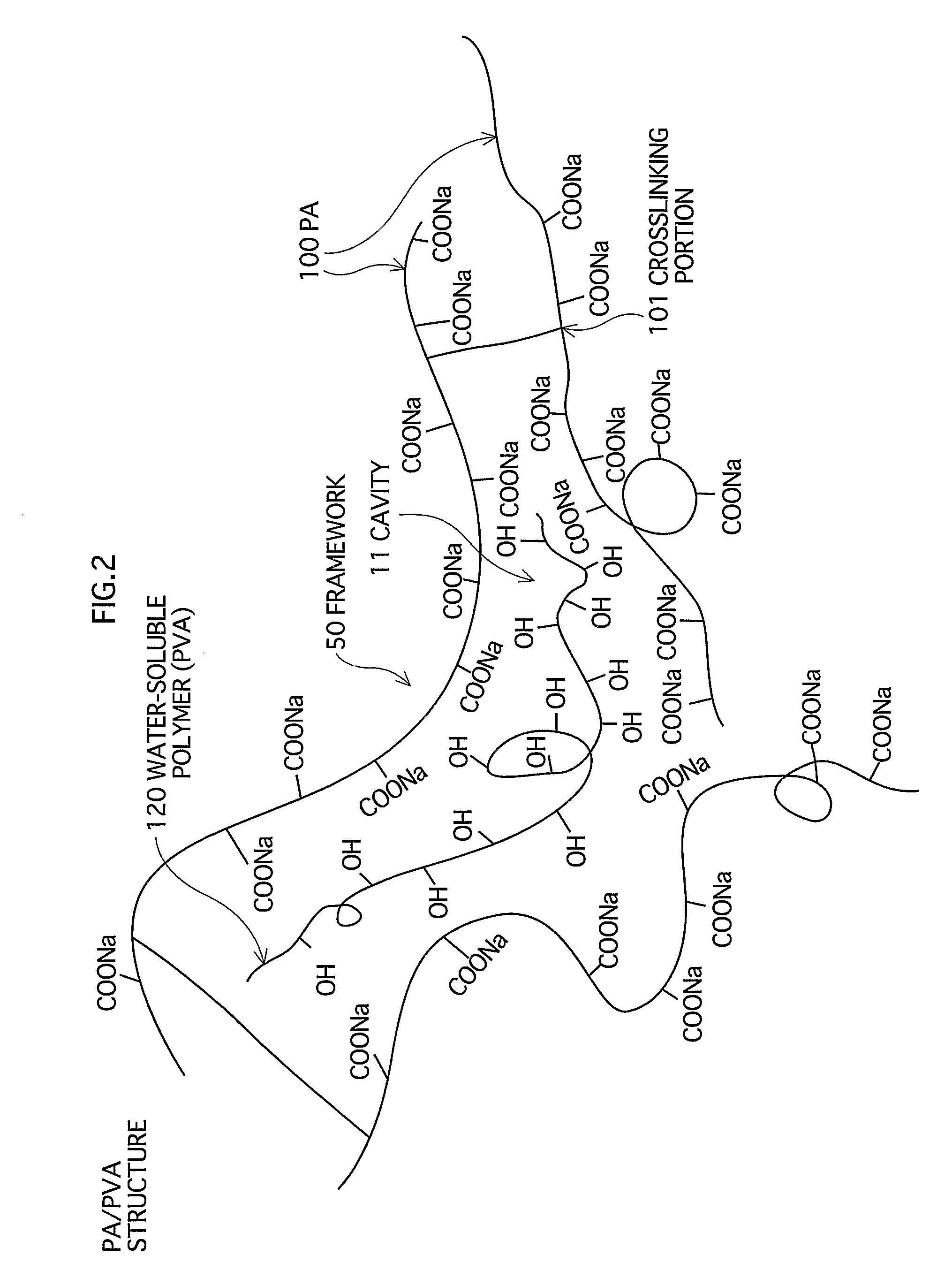Humidity conditioner and humidity conditioning method using the same
a technology of humidity conditioner and conditioner, which is applied in the direction of dispersed particle separation, other chemical processes, separation processes, etc., can solve the problems of affecting the effect of moisture absorption
- Summary
- Abstract
- Description
- Claims
- Application Information
AI Technical Summary
Benefits of technology
Problems solved by technology
Method used
Image
Examples
first embodiment
1. First Embodiment
1.1 Configuration of Humidity-Conditioning Sheet
[0048]FIGS. 1A and 1B show a configuration of a humidity-conditioning sheet 1 according to a first embodiment of the present invention. FIG. 1A is an external view of the humidity-conditioning sheet 1, and FIG. 1B is a cross sectional view of the humidity-conditioning sheet 1 along the line X-X′.
[0049] The humidity-conditioning sheet 1 has a configuration in which a humidity conditioner 10 in a particulate form is filled between two rectangular outer sheet members 2 (2a and 2b), and the hems of the outer sheet members 2a and 2b are sealed. The size of the humidity-conditioning sheet 1 is, for example, 10 cm×6 cm×1 mm.
[0050] The outer sheet members 2a and 2b, each of which has a thickness of, for example, approximately 200 μm, are composed of a material having excellent water permeability and a certain degree of mechanical strength, for instance, a non-woven fabric made of cellulosic fibers or aliphatic hydrocarbo...
second embodiment
2. Second Embodiment
[0188]FIG. 20 shows an example where the humidity-conditioning sheet 1 of the first embodiment is applied to clothing (a fatigue jacket) 300. In a second embodiment, the humidity-conditioning sheets 1 are attached to both underarm parts 310R and 310L of the fatigue jacket 300 from the inside in a detachable manner. In order to implement the humidity-conditioning sheets 1 in a detachable way, hook and loop fasteners (e.g. “magic tape” manufactured by Kuraray Co, Ltd.) may be used. Alternatively, two-sided tapes can be employed and laid on the surface of the outer sheet members 2a and 2b of the humidity-conditioning sheets 1. The humidity-conditioning sheets 1 may be set at other than the underarm parts (e.g. around a neckline and a waist).
[0189] Such a configuration allows to absorb sweat of a user wearing the fatigue jacket 300 in the case where the humidity-conditioning sheets 1 are used in a dry state. Herewith, it is possible to continue providing comfort to ...
third embodiment
3. Third Embodiment
[0192]FIG. 21 is a partial cross sectional view of the humidity-conditioning sheet 1 molded into a shape of nursery pot, showing a usage example of the humidity-conditioning sheet 1 of the first embodiment. The nursery pot 400 shown in the figure has practically the same configuration as the humidity-conditioner sheet 1 described above. That is, a granular humidity conditioner 402 is encased inside of a pot-shaped outer sheet member 401. The nursery pot 400 measures, for example, 5 cm in diameter and 8 cm in height on average. The nursery pot 400 is designed to hold a seedling 451 with soil 450. In order to mold the nursery pot 400, the commonly used extrusion molding can be employed.
[0193] The nursery pot 400 having such a configuration is capable of protecting the seedling 451 from drying out for a certain period of time by, for example, setting the nursery pot 400 in a water absorption state by having it absorb water in advance so as to be able to maintain the...
PUM
| Property | Measurement | Unit |
|---|---|---|
| Fraction | aaaaa | aaaaa |
| Fraction | aaaaa | aaaaa |
| Fraction | aaaaa | aaaaa |
Abstract
Description
Claims
Application Information
 Login to View More
Login to View More - R&D
- Intellectual Property
- Life Sciences
- Materials
- Tech Scout
- Unparalleled Data Quality
- Higher Quality Content
- 60% Fewer Hallucinations
Browse by: Latest US Patents, China's latest patents, Technical Efficacy Thesaurus, Application Domain, Technology Topic, Popular Technical Reports.
© 2025 PatSnap. All rights reserved.Legal|Privacy policy|Modern Slavery Act Transparency Statement|Sitemap|About US| Contact US: help@patsnap.com



